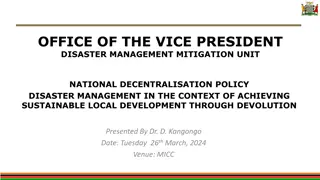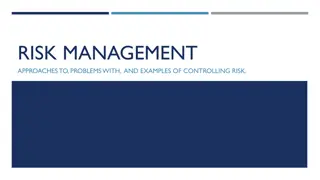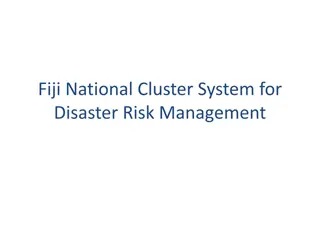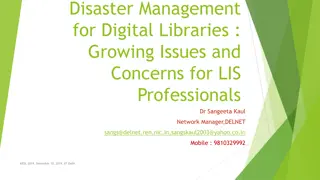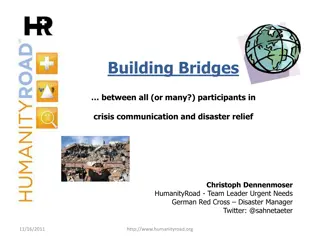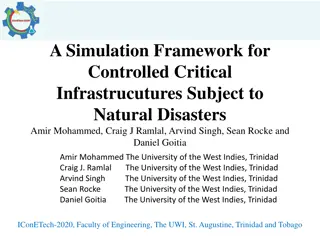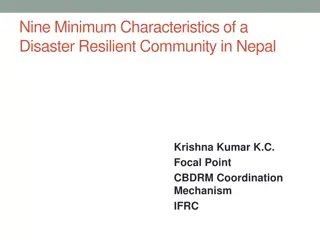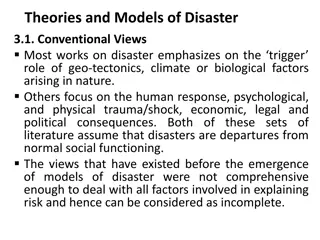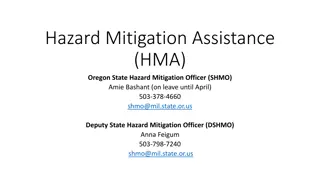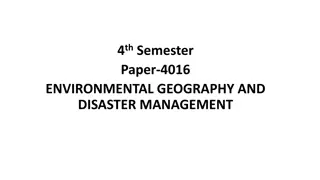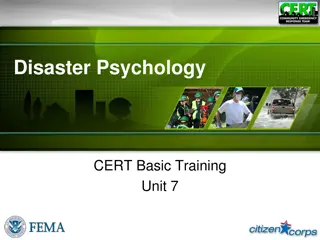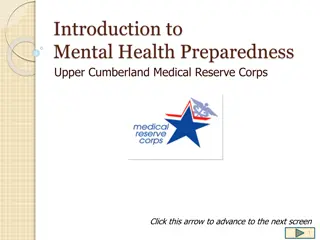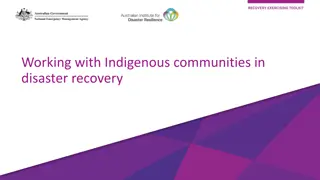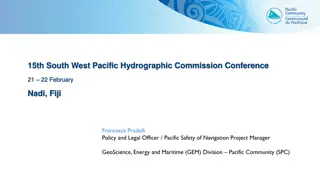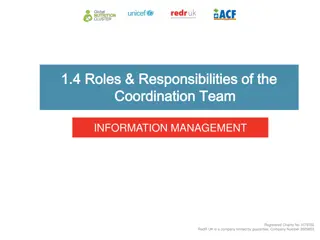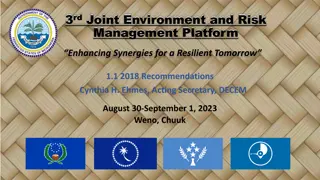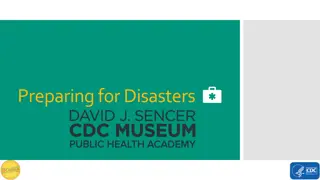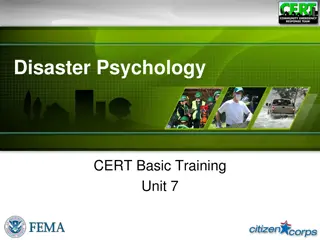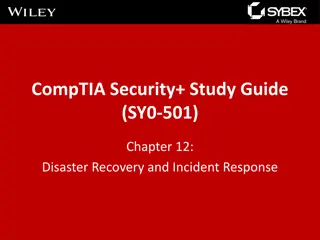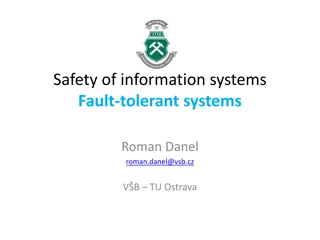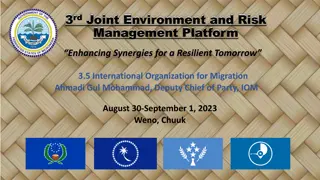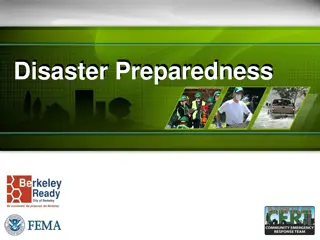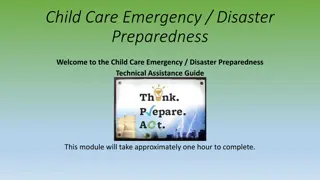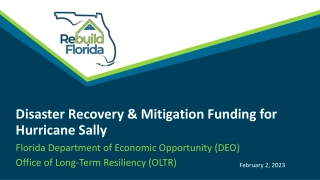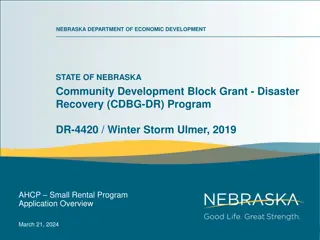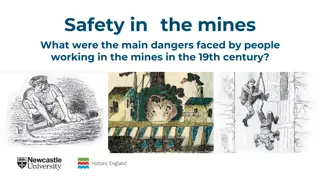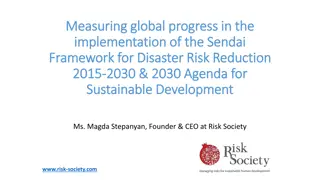Understanding Disaster Management: Definition, Impact, and Examples
A disaster is any occurrence causing damage, ecological disruption, or loss of life on a scale requiring an extraordinary response. This article explores the definition of disasters, their impact on communities and infrastructure, the importance of emergency response, types of hazards, vulnerability factors, and examples of disasters like cyclones, earthquakes, and epidemics.
Download Presentation

Please find below an Image/Link to download the presentation.
The content on the website is provided AS IS for your information and personal use only. It may not be sold, licensed, or shared on other websites without obtaining consent from the author. Download presentation by click this link. If you encounter any issues during the download, it is possible that the publisher has removed the file from their server.
E N D
Presentation Transcript
DISASTER MANAGEMENT BELLO C. B.
DEFINITION A disaster can be defined as any occurrence that causes damage, ecological disruption, loss of human life or deterioration of health and health services on a scale sufficient to warrant an extra ordinary response from outside the affected community area (Park, 2009). A disaster is an occurrence disrupting the normal conditions of existence and causing a level of suffering that exceeds the capacity of adjustment of the affected community.
INTRODUCTION Emergencies and disasters affect the health and well being of people It causes the displacement of many people, and many are often killed or injured or subjected to greater risk of epidemics. Disaster also has a negative implication , cause harm to existing infrastructure and inhibit sustainable development.
EMERGENCY A state in which normal procedures are suspended and extra-ordinary measures are taken in order to avert a terrible occurrence
HAZARD A natural or human-made effect that threatens to adversely affects human life, property or activity to the extent of causing a disaster.
VULNERABILITY The predisposition to suffer damage due to external events
DISASTER CONTD Disaster can occur anywhere, and anytime, as community grows and resources become more limited, communities become increasingly vulnerable to hazards that causes disasters Statistics gathered all over the world show a rise in the number of people affected by disasters (Park, 2009)
EXAMPLES OF DISASTER Cyclone Heat waves Volcanic eruptions Tidal waves Building collapse Epidemics Snow storm Hurricane Typhoons Terrorism Earthquake Severe Air pollution Floods Land slides Tornadoes Fires Draught/Famine Nuclear accidents Warfare
DISASTER CONTD Some of these catastrophic events can be predicted several hours or days before hand, such as Cyclones or Floods, others such as Earthquakes, volcanic eruptions occur without warning. The relative number of injuries and deaths differ, depending on a number of factors such as Type of disaster Time of the day it strikes The density and distribution of the population Condition of the environment Degree of the preparedness and opportunity of the warning.
CLASSIFICATION OF EFFECT OF DISASTER Morbidity which result from a disaster situation can be classified into four Injuries Emotional stress Epidemic of diseases Increase in indigenous diseases
SHORT TERM EFFECTS OF MAJOR DISASTERS Death Severe injuries requesting extensive treatment Increased risk of communicable diseases Damage to health facilities Damage to water systems Food shortage Major population movements
DISASTER MANAGEMENT There are three fundamental aspect of disaster management Disaster response Disaster preparedness Disaster mitigation These three aspect of disaster management correspond to different phases in the so called disaster cycle as shown below
DISASTER CYCLE Risk reduction phase Before a disaster Preparedness Response d Disaster impact impact Disaster ddd Mitigation Rehabilitation Reconstruction r Recovery phase after a disaster
DISASTER RESPONSE These are the set of activities implemented after the impact of a disaster in order to assess the needs reduce the suffering limit the spread and the consequences of the disaster open the way to rehabilitation
DISASTER RESPONSE CONTD Medical treatment is required for large number of casualties after certain type of disaster e.g Building collapse. As a result of the injuries sustained during the impact, emergency care is required in the first few hours
DISASTER RESPONSE CONTD Disaster response is discussed under the following subheadings 1. Search recue & first aid 2. Triage 3. Tagging 4. Care of dead 5. Relief phase
SEARCH RESCUE & FIRST AID Following a major disaster, as a result of large casualties that are involved there is the need for search rescue and first aid. Most times, organized relief services are only able to meet a small fraction of the demand, hence, uninjured survivors are often compelled to offer immediate help/ assistance.
SEARCH RESCUE & FIRST AID Casualties must be handled with care to prevent complications. Using all available transport system, all injured persons must be transported to the nearest health facilities.
SEARCH RESCUE & FIRST AID Providing proper care to casualties must be the goal of the facility. All health service resources must be redirected to this new priority, bed must be made available while surgical services must be maximized A centre should be established by the facility, to respond to inquiries from patient s relatives and friends. Priority should be given to victims identification and adequate mortuary space should be provided.
TRIAGE This is a medical treatment approach that is adopted when the quality and severity of injuries overwhelm the operative capacity of health facilities. The principle of first come, first treated is not followed in emergencies. Triage consists of rapidly classifying the injured on the basis of the severity of their injuries and the likelihood of their survival with prompt medical intervention.
TRIAGE Higher priority is given to victims whose immediate or long term prognosis can be dramatically affected by simple intensive care. Moribund patients, who require a great deal of attention with questionable benefit, have the lowest priority. Triage is the only approach that can provide maximum benefit to the greatest number of injured in a major disaster situation.
TRIAGE SYSTEM There are different triage systems but the most common classification uses the internationally accepted four color code system Red indicates high priority treatment or transfer Yellow indicate medium priority Green indicates ambulatory patient Black indicates dead or moribund patient
TRIAGE CONTD Triage should be carried out at the site of the disaster in order to determine transportation priority Patient needs and priority of medical care will be reassessed on admission to the hospital or treatment centre. Person with minor injuries should be treated at home to reduce pressure of transporting them to central facilities. The seriously injured should be transported to hospital with specialized treatment facilities.
TAGGING All patient should be identified with tags stating their name, age, place of origin, triage, category, diagnosis and initial treatment.
CARE OF THE DEAD Caring for the dead is an essential part of disaster management. Large number of dead bodies can impede the efficiency of the rescue activities at the site of disaster. Cares of the dead includes Removal of the dead from the disaster scene Transferring into the mortuary Identification
CARE OF THE DEAD CONTD Reception of bereaved relatives, proper respect must be given to the dead. Health hazards with cadavers are minimal when death result from trauma. When human bodies contaminate streams, well or other water sources as in floods etc. they may transmit gastroenteritis or food poisoning to survivors.
RELIEF PHASE Assistance from outside or within is one of the immediate demands. The type and quality of humanitarian relief supply are determined by 2 factors Type of disaster Type and quality of supply available locally When a disaster occurs, the most critical aspect is health supply needed to treat the casualty to prevent spread of communicable diseases (food, shelter, clothing, sanitary, engineering equipment, construction materials).
PRINCIPLES OF MANAGING HUMANITARIAN SUPPLY The four principles required in managing humanitarian supply are Acquisition of the supply Transportation of the supply Storage of the supply Distribution of the supply
REHABILITATION Rehabilitation starts from the very moment of the disaster and continue until the population is stabilized. Emergency shelter in form of tents or emergency houses are necessary facilities. Adequate supply of safe water ( quality and quantity) Facilities for the disposal of waste. Facilities for recreation such as ludo, draft and Ayo this occupy time and prevent suicide, prostitution, depression etc.
REHABILITATION CONTD Provide facilities for disposal of waste and ensure personal hygiene Ensure adequate supply of safe food, ensure kitchen hygiene to prevent food-borne diseases Control program for vector-borne diseases should be intensified Make provision for essential health service( sick bay). There must be proper arrangement for burial to prevent out break of diseases.
Epidemiological Surveillance and disease control in disaster management Avoid overcrowding and poor sanitation Prevent mass population displacement which may lead to increase in communicable diseases. Avoid disruption and contamination of water supply as well as damages to sewage system and power supply Avoid displacement of domestic and wild animals, who may carry zoonoses that can be transmitted to humans as well as other animals ( Leptospirosis, Anthrax)
Epidemiological Surveillance and disease control in disaster management Avoid disruption of routine control programme as funds and personnel are actually diverted to relief work Avoid ecological changes which may favor breeding of vectors and increase the vector population density. Source of food should be well monitored as provision of emergency food, water and shelter in disaster situation from different or new source may itself be a source of infection.
Epidemiological Surveillance and disease control in disaster management Organize a reliable disease reporting system to identify outbreak and to promptly initiate control measures. Investigate all reports of disease outbreak rapidly Vaccination where applicable Rehabilitation This is the final phase in disaster management and this is restoring individuals to their pre-disaster conditions
DISASTER PREPAREDNESS Disaster preparedness is a programme of long term development activities whose goals are to strengthen the overall capacity and capability of a country to manage efficiently all types of emergency Disaster preparedness is a multi-sectoral activity, it is an integral part of a national system that is responsible for developing plans and programs for disaster management.
DISASTER PREPAREDNESS The objective of disaster preparedness is to ensure that appropriate systems, procedures and resources are in place to provide prompt and effective assistance to disaster victims in order to reduce the impact.
EMERGENCY PREPAREDNESS CONTD Its the measures that ensure the organized mobilization of Personnel Funds Equipment and Supplies Within a safe environment for effective relief
EMERGENCY PREPAREDNESS CONTD The community is a major focus in emergency preparedness because members of the community are the most to gain from an effective and appropriate emergency preparedness program The community are those who first respond to an emergency especially in disaster that causes disruption of transport and communication system Resources are most easily pooled from the community
EMERGENCY PREPAREDNESS CONTD Sustained development is the best achieved by allowing emergency affected communities to design, manage, and implement internal and external assistance program
EMERGENCY PREPAREDNESS CONTD The context of emergency preparedness vary from country to country and from community to community. the following are the basic components of disaster preparedness
EMERGENCY PREPAREDNESS CONTD Evaluation of the risk of the country or particular region to disaster Adoption of standards and regulations Develop public education program Organize communication, information, and warning systems Co- ordinate information sessions with news media.
EMERGENCY PREPAREDNESS CONTD Ensure co-ordination and response mechanism Adopt measures to make financial and other resources available for increased readiness and can be mobilized in disaster situation Organize disaster simulation exercises that test response mechanisms
DISASTER MITIGATION Permanent reduction of the risk of disaster Reducing the PRESENCE of the Hazard Reducing VULNERABILITY
DISASTER MITIGATION CONTD Mitigation involves measure designed either to prevent hazards from causing emergency or to lessen the likely effects of emergency The main aim of mitigation measures is to reduce the vulnerability of the system. Mitigation measures include the following Flood mitigation works Appropriate land Use planning
DISASTER MITIGATION CONTD Improved building code Improving the structural quality of houses, schools, and other public and private buildings Ensuring the safety of health facilities and public health services including water supply and sewerage systems
NATIONAL AGENCIES INVOLVED IN DISASTER MANAGEMENT NEMA National Emergency Management Agency Several NGO Fire service Police Red cross Federal Road Safety commission
INTERNATIONAL AGENCIES CONCERNED WITH DISASTER U.N.D.R.O United Nation Disaster Relief Organization W.C.C World Council of Churches U.S.A.I.D United State agency for international development. U.N.H.C.R United Nation High Commission on Refugee Red Cross Society( International commission of Red cross) U.N.I.C.E.F United Nation International Children Emergency Fund
INTERNATIONAL AGENCIES CONCERNED WITH DISASTER WHO- World Health Organization FAO- Food & Agriculture Organization OCHA- United Nations office for the Co- ordination of Humanitarian Affairs WFP- World Food Programme U.N.D.P United Nation Development Project ECHO- European Community Humanitarian Office World Bank
Nursing responsibilities to prepare for & respond to disaster. Participate in national/local pre-disaster planning Cooperate in international programs in case of disasters in other countries. Assist communities in their action on environmental health problems. Work with community program to reduce harmful pollutants (chemical, biological or physical) in air, soil, water & food by industries or other human effort.
Improve nutrition Encourage family planning Assess environmental factors and pursue activities for the elimination or reduction of hazards. Educate the general public and all levels of nursing personnel in environmental and other health hazards especially those related to unacceptable levels of contamination Participate in research involve in discovering ways and means of improving living and working conditions
REFERENCES Basavanthapa, B. T., Community Health Nursing (2nd edition). Jaypee brothers medical publishers , New Delhi Park, K. (18th ediition) Park s textbook of preventive and social medicine. Banarsidas Bhanot Publishers, India. Olise, P. (2012) Primary Health Care for Sustainable Development. Ozege Publications Abuja









